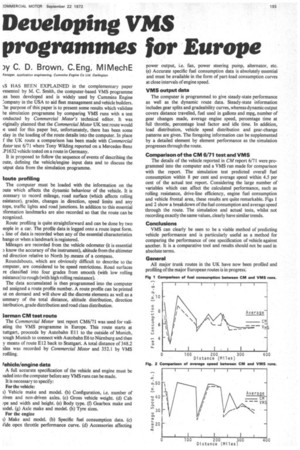Developing VMS programmes for Europe
Page 193

If you've noticed an error in this article please click here to report it so we can fix it.
)y C. D. Brown, C.Eng, MIMechE
4anager. application engineering, Cummins Engine Co Ltd, Darlington
6 HAS BEEN EXPLAINED in the complementary paper ,resented by M. C. Smith, the computer-based VMS programme as been developed and is widely used by Cummins Engine ;ompany in the USA to aid fleet management and vehicle builders. le purpose of this paper is to present some results which validate he simulation programme by comparing VMS runs with a test onducteal by Commercial Motor's technical editor. It was riginally planned that the Commercial Motor UK test route would
e used for this paper but, unfortunately, there has been some day in the loading of the route details into the computer. In place
f the UK route a comparison has been made with Commercial lotor test 6/71 where Tony Wilding reported on a Mercedes-Benz ,P1632 vehicle tested on a route in Germany.
It is proposed to follow the sequence of events of describing the oute, defining the vehicle/engine input data and to discuss the utput data from the simulation programme.
louts profiling The computer must be loaded with the information on the oute which affects the dynamic behaviour of the vehicle. It is ecessary to record mileage, road surface (which affects rolling esistance), grades, changes in direction, speed limits and any tops, traffic lights and road junctions. In addition to this essential iformation landmarks are also recorded so that the route can be ecognized.
Route profiling is quite straightforward and can be done by two eople in a car. The profile data is logged onto a route input form. L line of data is recorded when any of the essential characteristics hange or when a landmark is registered.
Mileages are recorded from the vehicle odometer (it is essential 3 know the accuracy of the instrument), altitude from the altimeter nd direction relative to North bylneans of a compass.
Roundabouts, which are obviously difficult to describe to the omputer, are considered to be speed restrictions. Road surfaces re classified into four grades from smooth (with low rolling esistance) to rough (with high rolling resistance).
The data accumulated is then programmed into the computer nd assigned a route profile number. A route profile can be printed ut on demand and will show all the discrete elements as well as a ummary of the total distance, altitude distribution, direction istribution, grade distribution and road class distribution.
ierman CM test route
The Commercial Motor test report CM6/71 was used for valiating the VMS programme in Europe. This route starts at tuttgart, proceeds by Autobahn El 1 to the outside of Munich, tough Munich to connect with Autobahn E6 to Ntirriburg and then y means of route E12 back to Stuttgart. A total distance of 348.2 files was recorded by Commercial Motor and 352.1 by VMS rofiling,
vehicle/engine data A full accurate specification of the vehicle and engine must be iaded into the computer before any VMS runs can be made. It is necessary to specify: For the vehicle:
i) Vehicle make and model. (b) Configuration, i.e. number of riven and non-driven axles. (c) Gross vehicle weight. (d) Cab ipe and width and height. (e) Body type. (1) Gearbox make and iodel. (g) Axle make and model. (h) Tyre sizes.
For the engine
L) Make and model. (b) Specific fuel consumption data. (c) Vide open throttle performance curve. (d) Accessories affecting power output, i.e. fan, power steering pump, alternator, etc. (e) Accurate specific fuel consumption data is absolutely essential and must be available in the form of part-load consumption curves at close intervals of engine speed.
VMS output data The computer is programmed to give steady-state performance as well as the dynamic route data. Steady-state information includes gear splits and gradeability curves, whereas dynamic output covers distance travelled, fuel used in gallons and mpg, number of gear changes made, average engine speed, percentage time at full throttle, percentage load factor and idle time. In addition, load distribution, vehicle speed distribution and gear-change patterns are given. The foregoing information can be supplemented by a detailed element by element performance as the simulation progresses through the route.
Comparison of the CM 6/71 test and VMS
The details of the vehicle reported in CM report 6/71 were programmed into the computer and a VMS run made for comparison with the report. The simulation test predicted overall fuel consumption within 8 per cent and average speed within 4.5 per cent of the actual test report. Considering the large number of variables which can affect the calculated performance, such as rolling resistance, drive-line efficiency, engine fuel consumption and vehicle frontal area, these results are quite remarkable. Figs 1 and 2 show a breakdown of the fuel consumption and average speed through the route. The simulation and actual tests, whilst not recording exactly the same values, clearly have similar trends.
Conclusions VMS can clearly be seen to be a viable method of predicting vehicle performance and is particularly useful as a method for comparing the performance of one specification of vehicle against another. It is a comparative tool and results should not be used in absolute terms.
General All major trunk routes in the UK have now been profiled and profiling of the major European routes is in progress:
































































































































































































































































































































































































































































































































